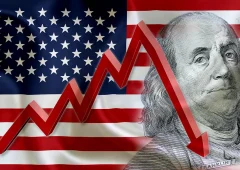U.S. Report on Inflation is Out – Here is What You Should Know
30.08.2024 15:30 1 min. read Alexander Stefanov
The PCE inflation report released moments ago will likely to reinforce expectations of an impending Federal Reserve interest rate cut.
For July, the core PCE Price Index increased by 0.2% month-over-month (MoM), maintaining the same growth rate as June. Annually, core PCE has risen by 2.6%, lower than expectations.
The core PCE Price Index, which omits the more volatile food and energy prices, plays a crucial role in shaping market expectations regarding the Fed’s interest rate decisions.
As it excludes erratic components, this indicator is closely watched by both the central bank and market participants to gain a clearer perspective on underlying inflation trends.
Earlier this month, data from the Bureau of Labor Statistics (BLS) revealed that the U.S. Consumer Price Index (CPI) increased by 2.9% annually in July, while the core CPI rose by 3.2%, slightly lower than the 3.3% recorded in June.
The Fed’s preferred inflation gauge for July shows a sustainable trend of disinflation, bolstering Federal Reserve officials’ confidence as they eye interest rate cuts next month.
-
1
Gold Beats U.S. Stock Market Over 25 Years, Even With Dividends Included
13.07.2025 15:00 1 min. read -
2
US Inflation Heats Up in June, Fueling Uncertainty Around Fed Cuts
15.07.2025 16:15 2 min. read -
3
U.S. Announces Sweeping New Tariffs on 30+ Countries
12.07.2025 16:30 2 min. read -
4
Robert Kiyosaki Predicts When The Price of Silver Will Explode
28.06.2025 16:30 2 min. read -
5
Key U.S. Economic Events to Watch Next Week
06.07.2025 19:00 2 min. read
US Inflation Heats Up in June, Fueling Uncertainty Around Fed Cuts
U.S. inflation accelerated in June, dealing a potential setback to expectations of imminent Federal Reserve rate cuts.
Gold Beats U.S. Stock Market Over 25 Years, Even With Dividends Included
In a surprising long-term performance shift, gold has officially outpaced the U.S. stock market over the past 25 years—dividends included.
U.S. Announces Sweeping New Tariffs on 30+ Countries
The United States has rolled out a broad set of new import tariffs this week, targeting over 30 countries and economic blocs in a sharp escalation of its trade protection measures, according to list from WatcherGuru.
Key U.S. Economic Events to Watch Next Week
After a week of record-setting gains in U.S. markets, investors are shifting focus to a quieter yet crucial stretch of macroeconomic developments.
-
1
Gold Beats U.S. Stock Market Over 25 Years, Even With Dividends Included
13.07.2025 15:00 1 min. read -
2
US Inflation Heats Up in June, Fueling Uncertainty Around Fed Cuts
15.07.2025 16:15 2 min. read -
3
U.S. Announces Sweeping New Tariffs on 30+ Countries
12.07.2025 16:30 2 min. read -
4
Robert Kiyosaki Predicts When The Price of Silver Will Explode
28.06.2025 16:30 2 min. read -
5
Key U.S. Economic Events to Watch Next Week
06.07.2025 19:00 2 min. read


